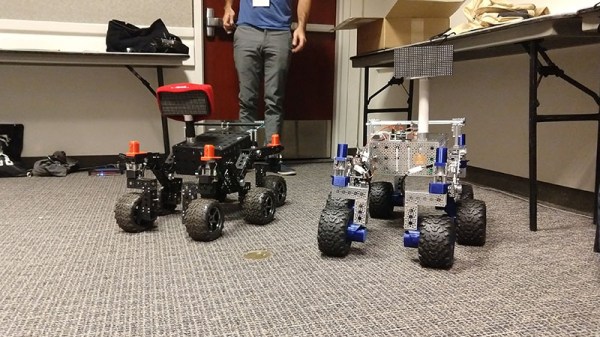If you want to creep everyone out, [Hunter Irving] has your back. He found a weird, creepy knock-off Thomas the Tank Engine toy and mounted a servo to it. This animatronic face is really, really creepy and has the aesthetic of a pastel plastic hell of the forgotten toys destroyed in a day care in 1991. It probably smells like a thrift shop. This rosy-cheeked locomotive shall derail your soul. It sings karaoke.
Like badges? Sure you do. Ph0xx is the badge for the upcoming Fri3d Camp, a family hacker, maker, and DIY camp in Belgium with 600 attendees. The badge features an ESP-32, two 5×7 LED arrays, accelerometer, an 18650 battery with protection and a charger, expansion headers, and this badge is compatible with Lego Technic. Oh yes, they went there.
We’re filing this under ‘but why’. It’s a custom Mercedes-Benz motorcycle, with a sidecar, that looks like an early 80s Benz convertible. [Maarten] stumbled upon a few pics of this, but the google-fu is weak in trying to get some information about this build. Who built it? Why? Does it run?
Here’s something near and dear to my heart: my greatest contribution to humanity so far. The Shitty Add-On spec for this year’s batch of Def Con badges is the reason badges now have their own badges. Now it’s time for a slight upgrade to the standard, and I need your help. The SAO standard 1.1bis will retain the VCC/GND/SDA/SCL layout of the first revision, but to increase mechanical stability and decrease the complexity of populating the headers, we’re adding two pins. Here’s the question: what should these two extra pins do? The current options are adding TX and RX to the standard, or two GPIOs that are undefined, but able to be utilized by each badge team for their own purposes. Those are the two options, but I’m looking for your input in the comments. Hurry up, because we have Superconference badges to build.
You should know the Primitive Technology channel on YouTube. This week he made another step towards the iron age. The basic idea behind this channel is a guy in Australia playing Minecraft in real life, building everything he can, starting with the technology of punching trees. The latest video shows his process for smelting iron. The iron comes from iron-bearing bacterial sludge found in a creek. The geologic disadvantages of northeastern Australia notwithstanding, he’s doing everything else right. He’s making charcoal, and turning that sludge into something that could be a bloom of iron.
























